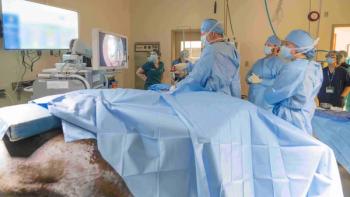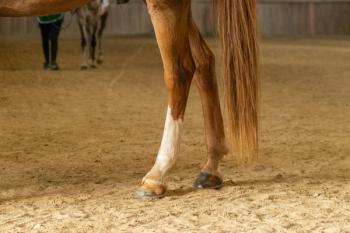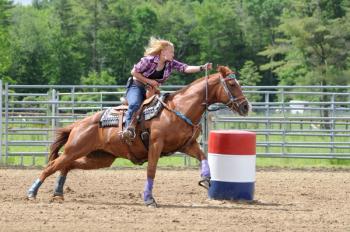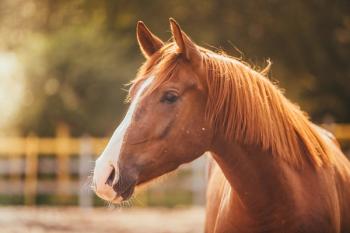
Vestibular disease in horses (Proceedings)
Vestibular disease may result from a number of infectious, traumatic and non-infectious conditions.
Vestibular disease may result from a number of infectious, traumatic and non-infectious conditions. Temporohyoid osteoarthropathy and head trauma are the most common causes of vestibular nerve disease in horses. Other causes include equine protozoal myelitis (EPM), neoplasia, brain abscess, West Nile, eastern and parasitic migration. Diagnostic tools include endoscopy of the guttural pouches, radiographs, computed tomography, and assessment of spinal fluid. Individual cases will be presented and discussed during the lecture.
Clinical signs of vestibular disease:
Head tilt: ventral deviation of the poll to the affected side (muzzle points away)
Nystagmus: With peripheral vestibular disease, the nystagmus is horizontal, and fast phase is away. With central vestibular disease, the nystagmus can be horizontal, vertical or rotary, and the type of direction of nystagmus may change with head position.
Recumbency/leaning: affected horses may prefer to lie on the side of the lesion
Circling: toward the lesion. The body may be flexed, with a concavity toward the lesion (due to extensor hypotonia on the affected side and mild extensor hypertonia on the contralateral side).
Ventrolateral strabismus: can be observed on the ipsilateral side. Best evaluated when head is elevated and extended. The strabismus due to vestibular disease results from abnormal upper motor neuron input to the oculomotor nerve
Ataxia but no weakness: are common in horses with severe vestibular disease.
Facial nerve paralysis: frequently occurs with vestibular nerve disease due to the proximity of the facial nerve to the vestibular nerve. Clinical signs of facial nerve paralysis include muzzle deviation away from the affected side, absent menace response, absent palpebral response, ear droop, and decreased nostril flare. Corneal ulceration can occur to decreased ability to blink and decreased tear production.
Temporohyoid osteoarthropathy:
The most common cause of acute vestibular nerve disease in horses
Pathophysiology: Temporohyoid osteoarthropathy is a chronic boney proliferation of the temporohyoid joint (stylohyoid and petrous temporal bones). The onset of neurologic dysfunction is acute. However the disease is actually due to a chronic boney proliferative process of the stylohyoid and petrous temporal bones. It is not clear if the boney proliferation is due to trauma, infection (otitis media) or nonseptic degenerative arthrosis. The proliferation results in ankylosis of the temporohyoid joint. Onset of neurologic signs occurs when a subsequent fracture results.
Clinical signs: Acute onset of either unilateral facial and/or vestibular nerve disease. In a few cases, there is discharge from the affected ear (blood, purulent exudate or spinal fluid). Dysphagia can result from pain from the fracture or damage to the vagus and glossopharyngeal nerve, but is not a common occurrence. Some owners report head throwing, ear rubbing, and bridling problems for several weeks or months prior to development of neurological signs.
Diagnosis: Endoscopic examination of the guttural pouches is usually the easiest way to confirm a diagnosis. Osseous proliferation of the proximal end or the entire stylohyoid bone confirms the diagnosis. It is helpful to compare the both stylohyoid bones to each other. Bilateral disease is reported. Skull radiographs (lateral and ventrodorsal) can reveal osseous proliferation of the proximal stylohyoid bone and tympanic bulla. It may be difficult to adequately position the head in standing horses with vestibular disease (due to a head tilt and ataxia). Computed tomography provides the best imaging of this area, but requires general anesthesia.
Treatment: Most horses will respond to conservative medical management (broad spectrum antibiotics, non-steroidal drugs, and if necessary treating corneal ulcers). The majority of horses will significantly improve, and can be used athletically. However, most will still have mild facial or vestibular nerve disease. Acute death, meningitis, and seizures have been rarely reported. Surgery: Removal of a portion of the stylohyoid bone has been done to prevent further fractures of the temporohyoid joint. However, regrowth can occur. Alternatively a ceratohyoidectomy (removal of the entire ceratohyoid) is an easier surgery. The best surgical candidates are horses with temporohyoid osteoathropathy that have not yet developed neurological signs. This surgery has also been performed on horses with neurological disease.
Head trauma: Basilar skull fractures.
Basilar skull fractures occur when horses flip over backwards and impact their poll. These fractures most commonly involve the basisphenoid, basioccipital, and temporal bones. Basisphenoid fractures often occur at the suture between the basisphenoid and basioccipital bones.
Clinical signs: loss of consciousness for minutes to hours is common. Some horses never regain consciousness. Other clinical signs noted, once consciousness include vestibular dysfunction, facial nerve paralysis, depression, hemorrhage (from ears or nostrils), depression and ataxia. Leakage of spinal fluid or hemorrhage from the ears indicates a fracture of the petrous temporal bones. Basisphenoid fractures can lacerate the basilar artery and can result in massive life threatening hemorrhage.
Diagnosis: In many cases – the history will provide the diagnosis. However, in some cases the history is unknown. Diagnostics include skull radiographs and/or endoscopic examination. These fractures usually have minimal displacement, and a fracture line can be difficult to detect. An endoscopic examination will usually reveal blood in the pharynx or guttural pouches, or hemorrhage within the walls of the upper airway.
Treatment: Early (< 8 hours) prevention/treatment of brain edema. Anti-inflammatory drugs are recommended, in many cases steroids (dexamethasone 0.1 mg/kg q 12 hours). Non-steroidal anti-inflammatory drugs have minimal effect to reduce CNS edema, but may provide better analgesia. Mannitol (1 g/kg IV over 20 minutes as a 20% solution, q 8 to 12 hr) will reduce CNS edema, but should not be administered if there is any active hemorrhage into the brain. Seizures are best treated initially with diazepam (15 mg IV). If seizures are uncontrollable, phenobarbital (5-10 mg/kg IV), can be used. Phenobarbital will also produce depression, and altered consciousness. Broad-spectrum antibiotics are indicated for open fractures.
Prognosis: Grave to extremely poor prognosis if recumbent or unconscious for greater than 4 hours. If standing- good prognosis for life. There are several reports of horses used as performance horses.
Newsletter
From exam room tips to practice management insights, get trusted veterinary news delivered straight to your inbox—subscribe to dvm360.




